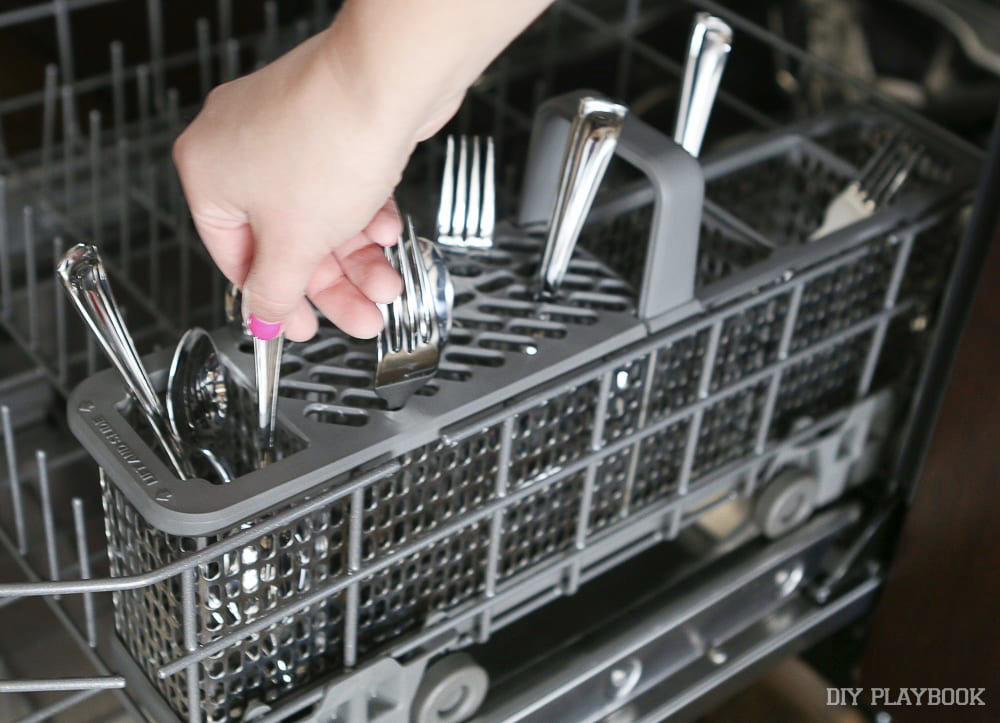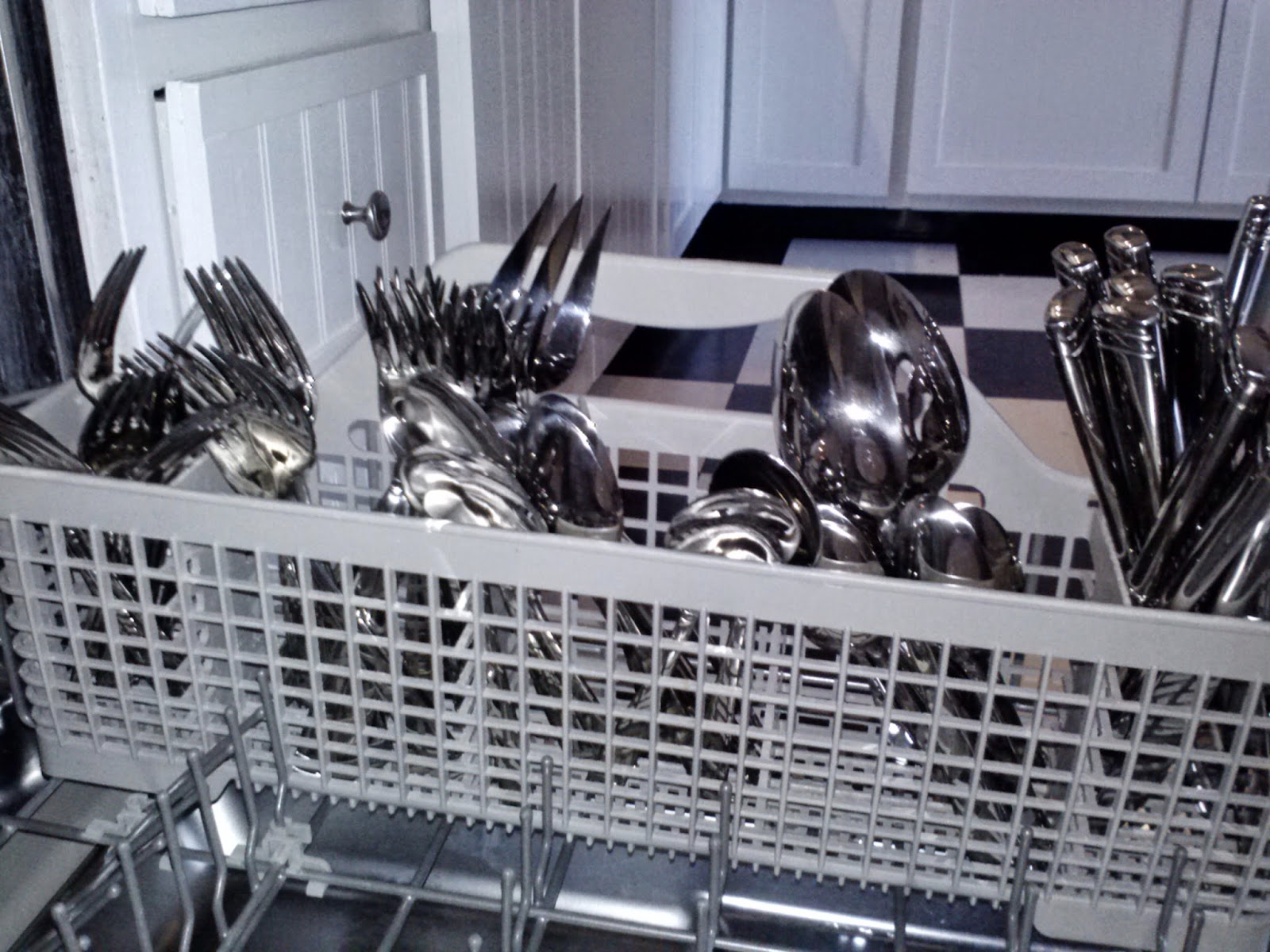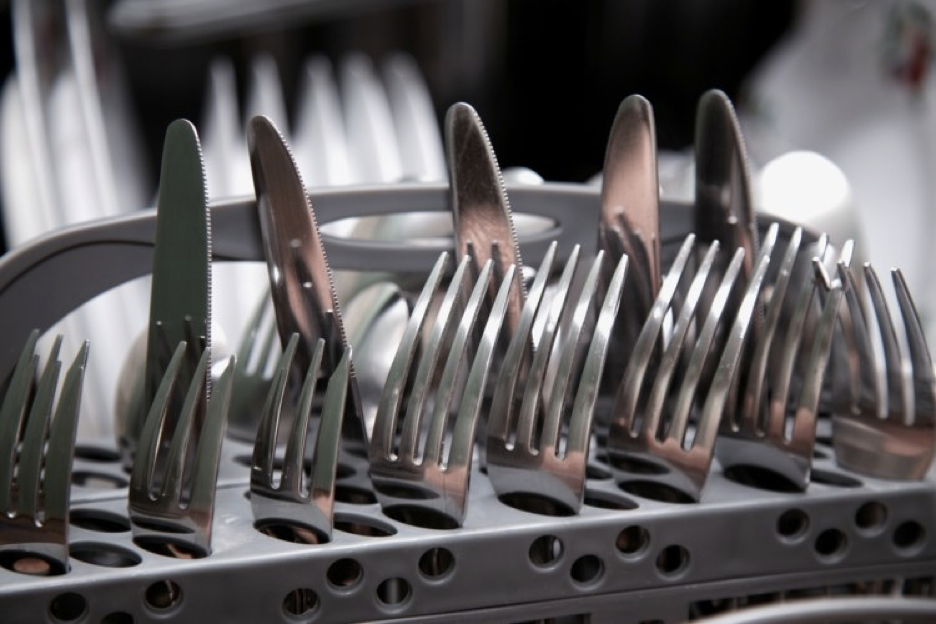The MOST RIGHT Way to Place Silverware in the Dishwasher!
Last month I read a great article in MARTHA STEWART LIVING by Nashia Baker, regarding silverware in the dishwasher. She interviewed some experts who explained how to get your utensils clean—while keeping them safe—in this appliance.

When I first saw the article title, I thought, “How hard can it be? Can’t your silverware just go right into the dishwasher. What’s the trick?”
Well, aside from whether to rinse first or not rinse first (depending on your dishwasher instructions and your personal preference), there's one key detail to consider as you load silverware. Should you place your utensils point up or down?
Turns out, this too, is largely based on personal preference. Nashia wondered if there wasn’t more to it than that, though, so she asked a few appliance experts to explain if there really was a proper way to place your silverware into your machine (UP or DOWN?) so it all gets as clean as possible, while remaining intact at the end of a cycle.

Her main, and simple question met with general consensus. Appliance gurus all agreed; personal preference aside, there are some basic rules of thumb to follow. For instance:
YES! Point items down—with their handles up. It’s the more hygienic method since you’ll only touch the handle when unloading the dishwasher. There is a downside to this approach, however: The more utensils you pile into the flatware holder in your dishwasher, the more crowded the space will be. Therefore, be sure to spread them out as evenly as possible for the most thorough cleaning.
It’s also a good idea to point everything with a sharp edge facing down, for safety's sake. However, there are certain hazardous items that should NEVER see the inside of this appliance. Steak knives, carving knives, and butchering knives—where the handle is made of something besides one piece of metal—should not be put in the dishwasher at all. The heat and force of the water can expand and contract the handles, causing them to break or come loose. Plus, loose handles or cracks in your silverware could attract bacteria.
It's important to use your machine correctly. While the direction in which your flatware points might be a personal preference, the truly important thing is that you use the designated slots in your machine's utensil rack to prevent utensils from sticking together. This practice also keeps them free of any water marks. And while rusting is uncommon, you can actively ward it off it by adding any silver-plated silverware and stainless-steel cutlery to separate compartments. When different metals are placed next to each other, contact corrosion can happen, which can cause metals to rust.

And here’s professional advice regarding that “rinse first or not to rinse first?” debate. The pros say you should also give your tools a solid rinsing before placing them into the appliance. Often times, foods with high acidity or salt can cause your silverware to rust, so rinsing before you load it in the dishwasher can help prevent the rust from forming. Their bottom line: opt for the ounce of prevention and ward off rusting by placing different metals in different compartments.
Finally, look through your manual for loading instructions (some brands offer clear tips that offer distinct advantages, if followed). This will give the best advice on how to point your silverware. After all, appliance manufacturers test for these sorts of issues prior to placing their machines on the market.

Today, most newer models are built to clean your dishes and utensils, regardless of how you place them in the racks. So maybe the above counsel is more for those with older models? But in the end, it’s always better to be safe than sorry, whatever the age of your appliance!
And one final silverware tip from appliance professionals: If you ever feel concerned about placing any piece of silverware in the dishwasher to begin with, do some research, either on the utensil type or its brand—to make sure all is well before you run it through (yup…better safe than sorry!).
blog comments powered by Disqus

When I first saw the article title, I thought, “How hard can it be? Can’t your silverware just go right into the dishwasher. What’s the trick?”
Well, aside from whether to rinse first or not rinse first (depending on your dishwasher instructions and your personal preference), there's one key detail to consider as you load silverware. Should you place your utensils point up or down?
Turns out, this too, is largely based on personal preference. Nashia wondered if there wasn’t more to it than that, though, so she asked a few appliance experts to explain if there really was a proper way to place your silverware into your machine (UP or DOWN?) so it all gets as clean as possible, while remaining intact at the end of a cycle.

Her main, and simple question met with general consensus. Appliance gurus all agreed; personal preference aside, there are some basic rules of thumb to follow. For instance:
YES! Point items down—with their handles up. It’s the more hygienic method since you’ll only touch the handle when unloading the dishwasher. There is a downside to this approach, however: The more utensils you pile into the flatware holder in your dishwasher, the more crowded the space will be. Therefore, be sure to spread them out as evenly as possible for the most thorough cleaning.
It’s also a good idea to point everything with a sharp edge facing down, for safety's sake. However, there are certain hazardous items that should NEVER see the inside of this appliance. Steak knives, carving knives, and butchering knives—where the handle is made of something besides one piece of metal—should not be put in the dishwasher at all. The heat and force of the water can expand and contract the handles, causing them to break or come loose. Plus, loose handles or cracks in your silverware could attract bacteria.
It's important to use your machine correctly. While the direction in which your flatware points might be a personal preference, the truly important thing is that you use the designated slots in your machine's utensil rack to prevent utensils from sticking together. This practice also keeps them free of any water marks. And while rusting is uncommon, you can actively ward it off it by adding any silver-plated silverware and stainless-steel cutlery to separate compartments. When different metals are placed next to each other, contact corrosion can happen, which can cause metals to rust.

And here’s professional advice regarding that “rinse first or not to rinse first?” debate. The pros say you should also give your tools a solid rinsing before placing them into the appliance. Often times, foods with high acidity or salt can cause your silverware to rust, so rinsing before you load it in the dishwasher can help prevent the rust from forming. Their bottom line: opt for the ounce of prevention and ward off rusting by placing different metals in different compartments.
Finally, look through your manual for loading instructions (some brands offer clear tips that offer distinct advantages, if followed). This will give the best advice on how to point your silverware. After all, appliance manufacturers test for these sorts of issues prior to placing their machines on the market.

Today, most newer models are built to clean your dishes and utensils, regardless of how you place them in the racks. So maybe the above counsel is more for those with older models? But in the end, it’s always better to be safe than sorry, whatever the age of your appliance!
And one final silverware tip from appliance professionals: If you ever feel concerned about placing any piece of silverware in the dishwasher to begin with, do some research, either on the utensil type or its brand—to make sure all is well before you run it through (yup…better safe than sorry!).
Sources:
- www.thediyplaybook.com
- www.meemaeats.com
- www.tiphero.com
- www.neff-home.com
 Alice Osborne
Alice Osborne
Weekly Newsletter Contributor since 2006
Email the author! alice@dvo.com
